Comparative Study: Homeownership Rates in Australia and Netherlands
VerifiedAdded on 2021/05/31
|19
|4047
|331
Report
AI Summary
This report provides a comprehensive comparison of homeownership rates in Australia and the Netherlands. It begins with an introduction to homeownership rates and their significance, followed by a clear articulation of the project's objectives and scope. The study delves into a thorough literature review, examining the impact of demographic conditions, economic factors, and political influences on homeownership trends in both countries. The review also explores the role of homeownership subsidies and private investors. The research employs both qualitative and quantitative methodologies, including sampling, data collection methods, and analysis techniques. The report addresses research limitations and concludes with a summary of findings and recommendations, offering valuable insights into the factors that shape homeownership rates in these two distinct nations.
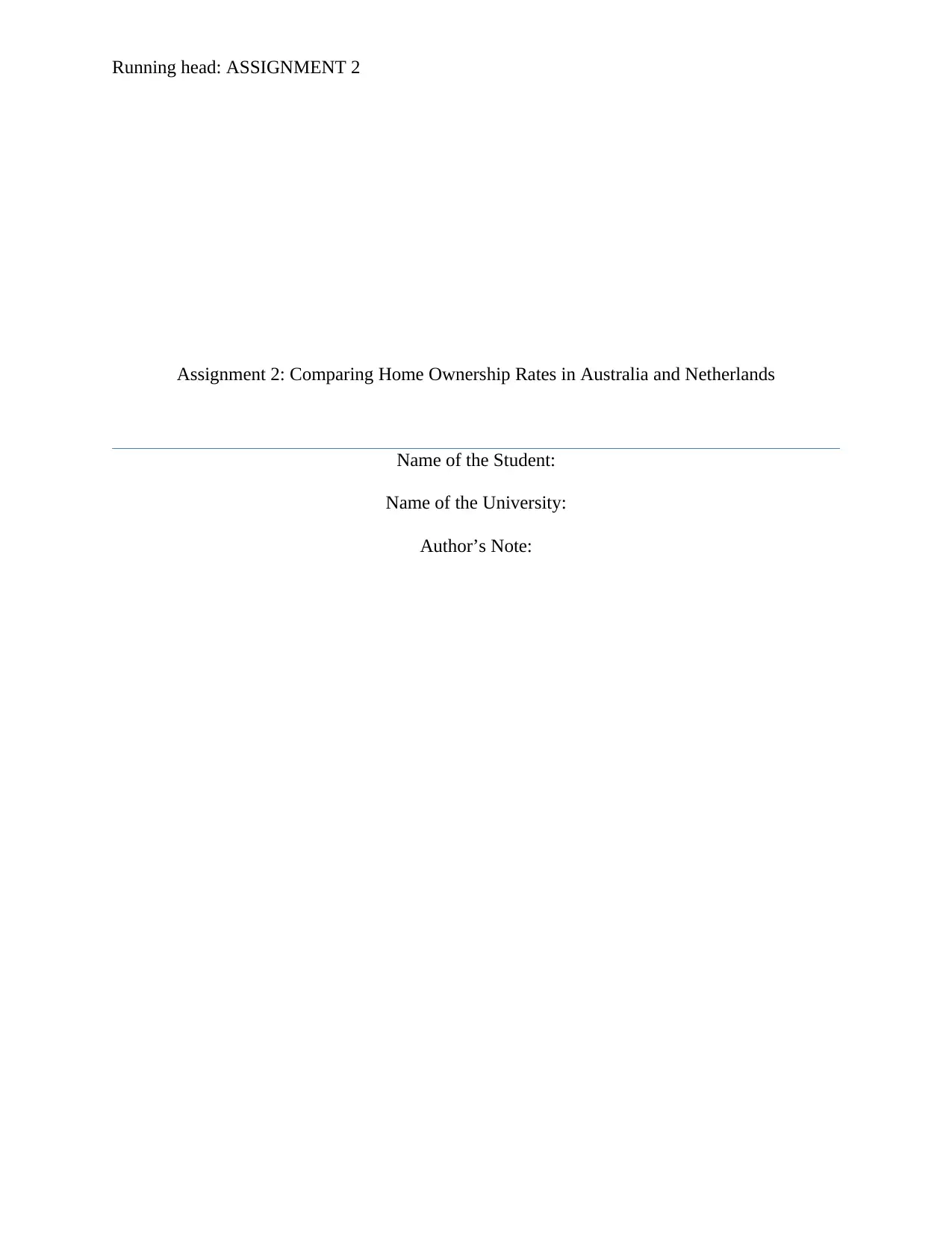
Running head: ASSIGNMENT 2
Assignment 2: Comparing Home Ownership Rates in Australia and Netherlands
Name of the Student:
Name of the University:
Author’s Note:
Assignment 2: Comparing Home Ownership Rates in Australia and Netherlands
Name of the Student:
Name of the University:
Author’s Note:
Paraphrase This Document
Need a fresh take? Get an instant paraphrase of this document with our AI Paraphraser
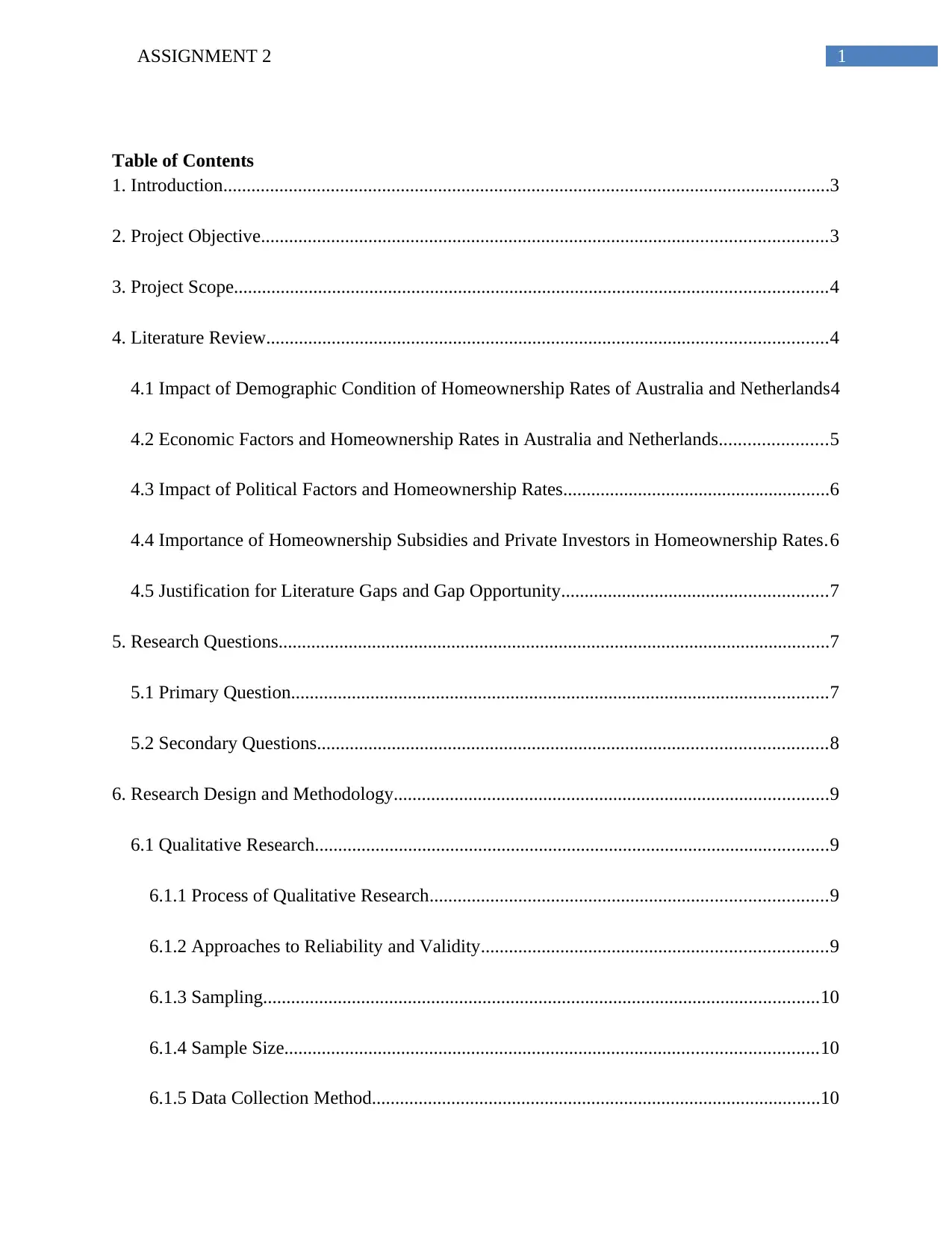
1ASSIGNMENT 2
Table of Contents
1. Introduction..................................................................................................................................3
2. Project Objective.........................................................................................................................3
3. Project Scope...............................................................................................................................4
4. Literature Review........................................................................................................................4
4.1 Impact of Demographic Condition of Homeownership Rates of Australia and Netherlands4
4.2 Economic Factors and Homeownership Rates in Australia and Netherlands.......................5
4.3 Impact of Political Factors and Homeownership Rates.........................................................6
4.4 Importance of Homeownership Subsidies and Private Investors in Homeownership Rates.6
4.5 Justification for Literature Gaps and Gap Opportunity.........................................................7
5. Research Questions......................................................................................................................7
5.1 Primary Question...................................................................................................................7
5.2 Secondary Questions.............................................................................................................8
6. Research Design and Methodology.............................................................................................9
6.1 Qualitative Research..............................................................................................................9
6.1.1 Process of Qualitative Research.....................................................................................9
6.1.2 Approaches to Reliability and Validity..........................................................................9
6.1.3 Sampling.......................................................................................................................10
6.1.4 Sample Size..................................................................................................................10
6.1.5 Data Collection Method................................................................................................10
Table of Contents
1. Introduction..................................................................................................................................3
2. Project Objective.........................................................................................................................3
3. Project Scope...............................................................................................................................4
4. Literature Review........................................................................................................................4
4.1 Impact of Demographic Condition of Homeownership Rates of Australia and Netherlands4
4.2 Economic Factors and Homeownership Rates in Australia and Netherlands.......................5
4.3 Impact of Political Factors and Homeownership Rates.........................................................6
4.4 Importance of Homeownership Subsidies and Private Investors in Homeownership Rates.6
4.5 Justification for Literature Gaps and Gap Opportunity.........................................................7
5. Research Questions......................................................................................................................7
5.1 Primary Question...................................................................................................................7
5.2 Secondary Questions.............................................................................................................8
6. Research Design and Methodology.............................................................................................9
6.1 Qualitative Research..............................................................................................................9
6.1.1 Process of Qualitative Research.....................................................................................9
6.1.2 Approaches to Reliability and Validity..........................................................................9
6.1.3 Sampling.......................................................................................................................10
6.1.4 Sample Size..................................................................................................................10
6.1.5 Data Collection Method................................................................................................10
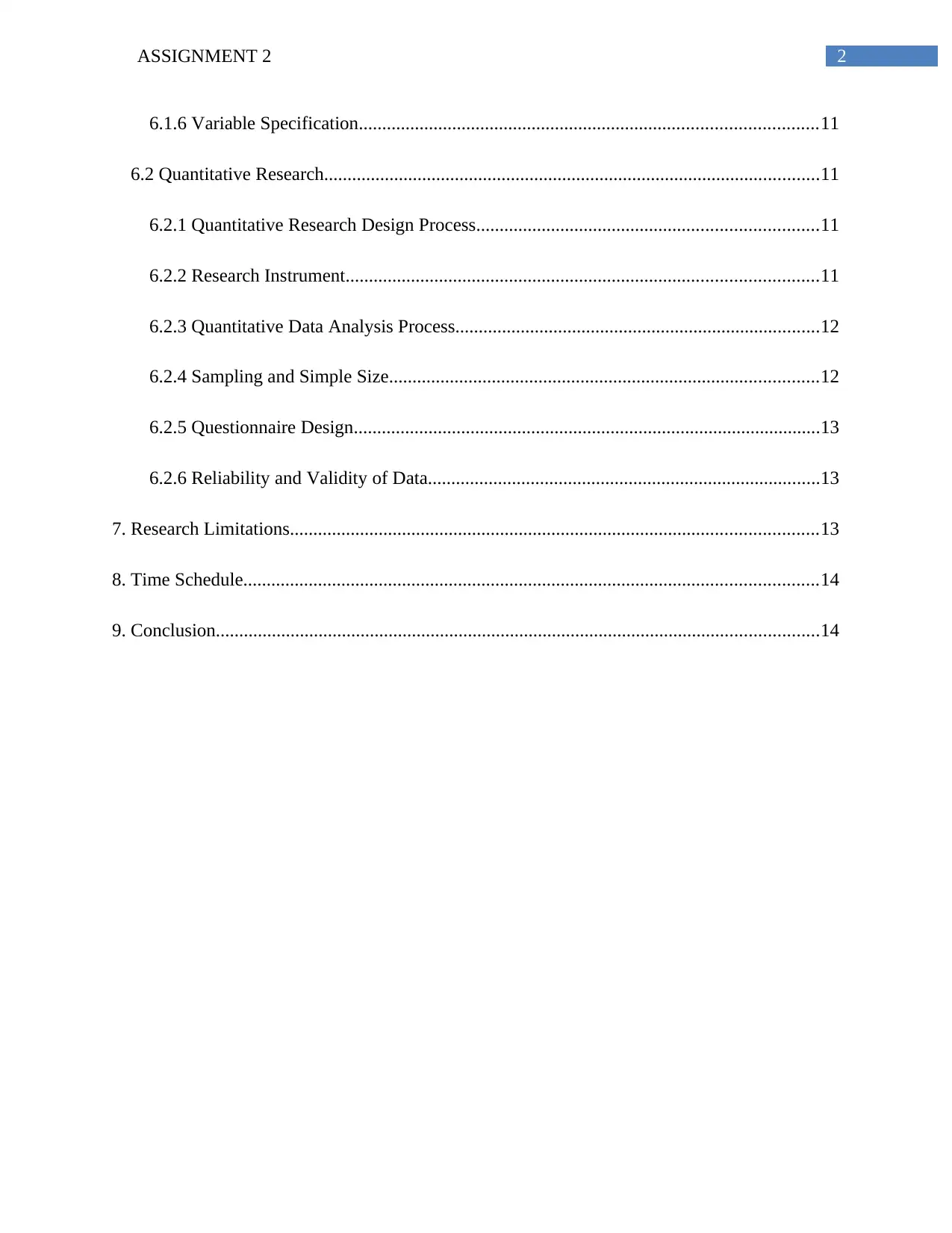
2ASSIGNMENT 2
6.1.6 Variable Specification..................................................................................................11
6.2 Quantitative Research..........................................................................................................11
6.2.1 Quantitative Research Design Process.........................................................................11
6.2.2 Research Instrument.....................................................................................................11
6.2.3 Quantitative Data Analysis Process..............................................................................12
6.2.4 Sampling and Simple Size............................................................................................12
6.2.5 Questionnaire Design....................................................................................................13
6.2.6 Reliability and Validity of Data....................................................................................13
7. Research Limitations.................................................................................................................13
8. Time Schedule...........................................................................................................................14
9. Conclusion.................................................................................................................................14
6.1.6 Variable Specification..................................................................................................11
6.2 Quantitative Research..........................................................................................................11
6.2.1 Quantitative Research Design Process.........................................................................11
6.2.2 Research Instrument.....................................................................................................11
6.2.3 Quantitative Data Analysis Process..............................................................................12
6.2.4 Sampling and Simple Size............................................................................................12
6.2.5 Questionnaire Design....................................................................................................13
6.2.6 Reliability and Validity of Data....................................................................................13
7. Research Limitations.................................................................................................................13
8. Time Schedule...........................................................................................................................14
9. Conclusion.................................................................................................................................14
⊘ This is a preview!⊘
Do you want full access?
Subscribe today to unlock all pages.

Trusted by 1+ million students worldwide
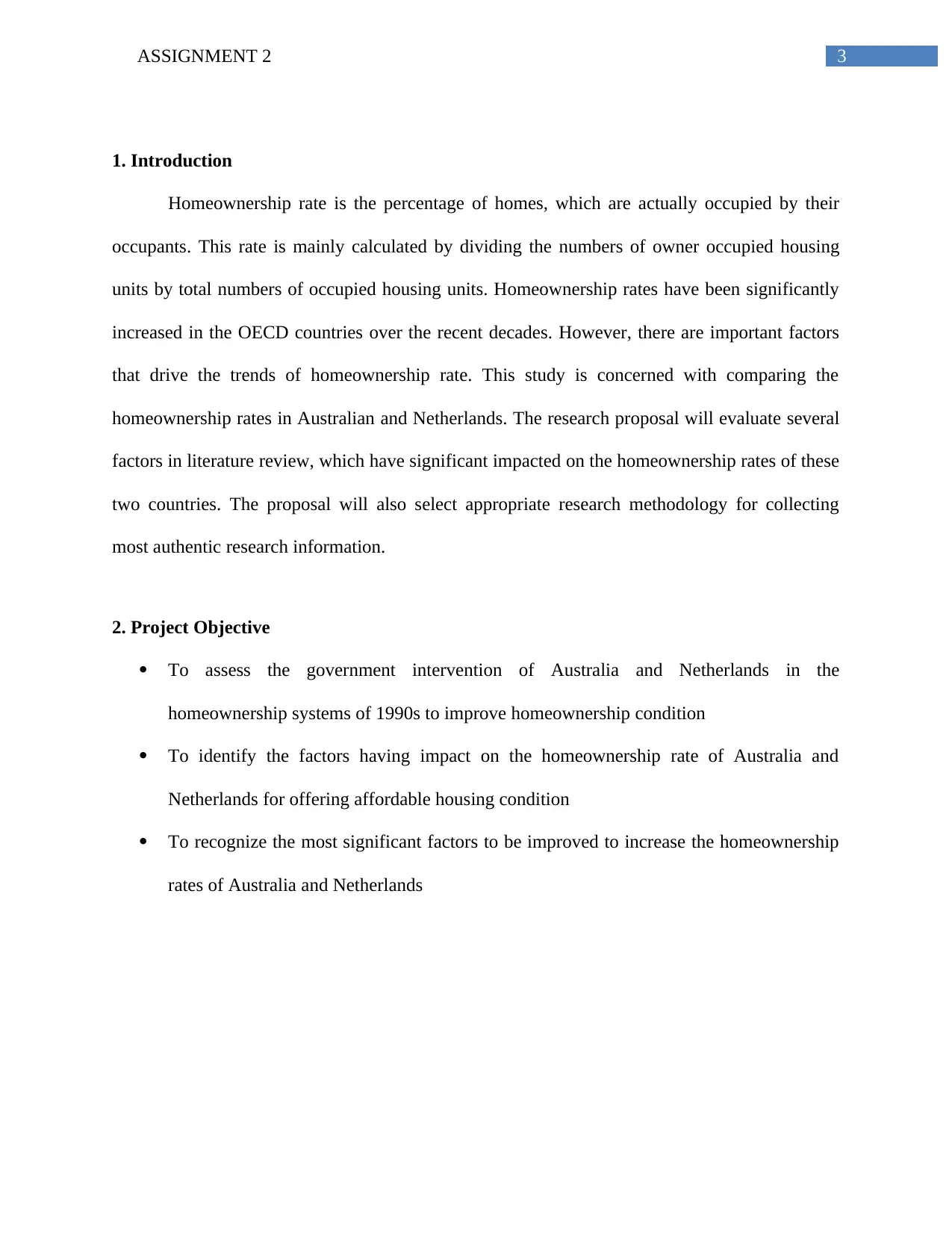
3ASSIGNMENT 2
1. Introduction
Homeownership rate is the percentage of homes, which are actually occupied by their
occupants. This rate is mainly calculated by dividing the numbers of owner occupied housing
units by total numbers of occupied housing units. Homeownership rates have been significantly
increased in the OECD countries over the recent decades. However, there are important factors
that drive the trends of homeownership rate. This study is concerned with comparing the
homeownership rates in Australian and Netherlands. The research proposal will evaluate several
factors in literature review, which have significant impacted on the homeownership rates of these
two countries. The proposal will also select appropriate research methodology for collecting
most authentic research information.
2. Project Objective
To assess the government intervention of Australia and Netherlands in the
homeownership systems of 1990s to improve homeownership condition
To identify the factors having impact on the homeownership rate of Australia and
Netherlands for offering affordable housing condition
To recognize the most significant factors to be improved to increase the homeownership
rates of Australia and Netherlands
1. Introduction
Homeownership rate is the percentage of homes, which are actually occupied by their
occupants. This rate is mainly calculated by dividing the numbers of owner occupied housing
units by total numbers of occupied housing units. Homeownership rates have been significantly
increased in the OECD countries over the recent decades. However, there are important factors
that drive the trends of homeownership rate. This study is concerned with comparing the
homeownership rates in Australian and Netherlands. The research proposal will evaluate several
factors in literature review, which have significant impacted on the homeownership rates of these
two countries. The proposal will also select appropriate research methodology for collecting
most authentic research information.
2. Project Objective
To assess the government intervention of Australia and Netherlands in the
homeownership systems of 1990s to improve homeownership condition
To identify the factors having impact on the homeownership rate of Australia and
Netherlands for offering affordable housing condition
To recognize the most significant factors to be improved to increase the homeownership
rates of Australia and Netherlands
Paraphrase This Document
Need a fresh take? Get an instant paraphrase of this document with our AI Paraphraser
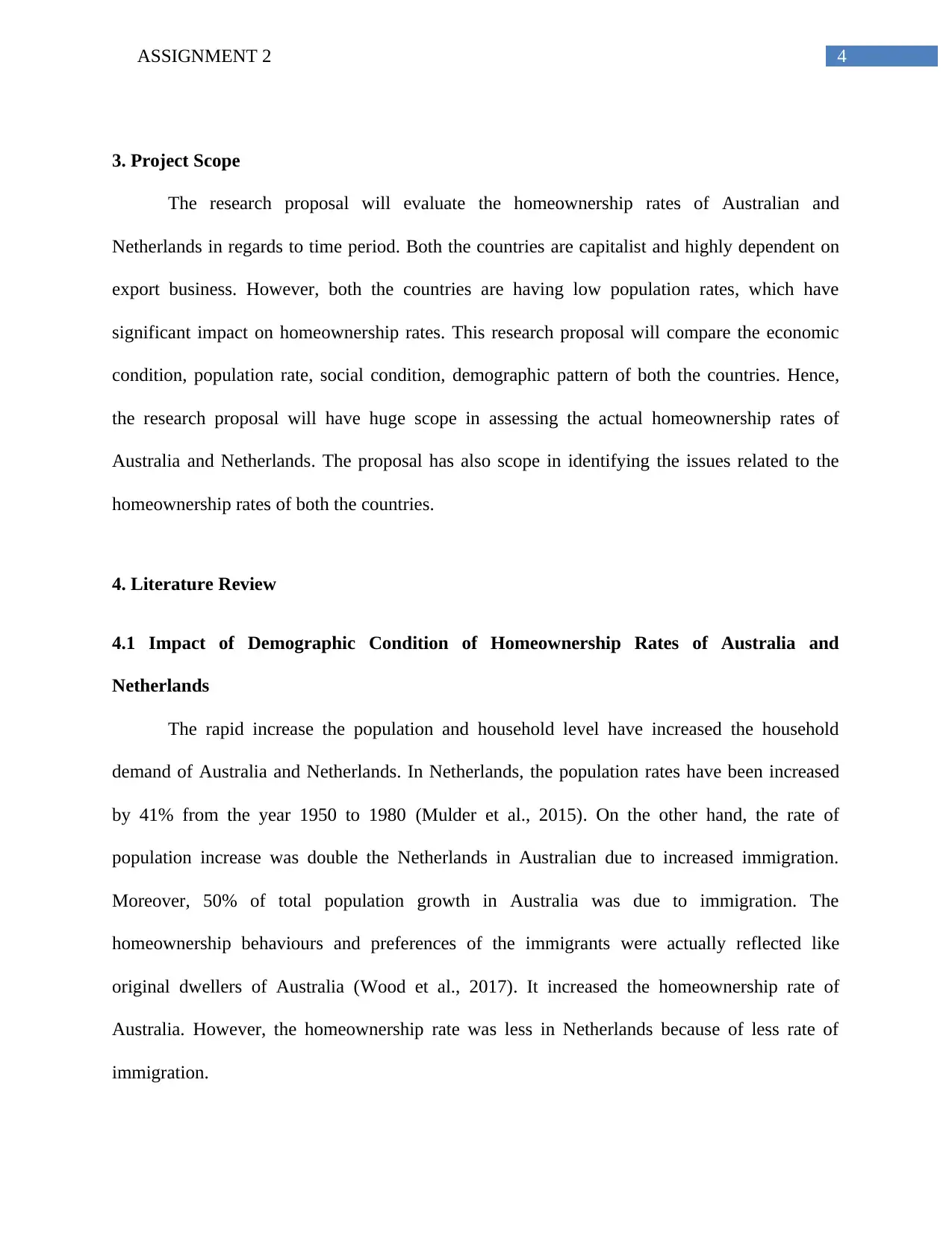
4ASSIGNMENT 2
3. Project Scope
The research proposal will evaluate the homeownership rates of Australian and
Netherlands in regards to time period. Both the countries are capitalist and highly dependent on
export business. However, both the countries are having low population rates, which have
significant impact on homeownership rates. This research proposal will compare the economic
condition, population rate, social condition, demographic pattern of both the countries. Hence,
the research proposal will have huge scope in assessing the actual homeownership rates of
Australia and Netherlands. The proposal has also scope in identifying the issues related to the
homeownership rates of both the countries.
4. Literature Review
4.1 Impact of Demographic Condition of Homeownership Rates of Australia and
Netherlands
The rapid increase the population and household level have increased the household
demand of Australia and Netherlands. In Netherlands, the population rates have been increased
by 41% from the year 1950 to 1980 (Mulder et al., 2015). On the other hand, the rate of
population increase was double the Netherlands in Australian due to increased immigration.
Moreover, 50% of total population growth in Australia was due to immigration. The
homeownership behaviours and preferences of the immigrants were actually reflected like
original dwellers of Australia (Wood et al., 2017). It increased the homeownership rate of
Australia. However, the homeownership rate was less in Netherlands because of less rate of
immigration.
3. Project Scope
The research proposal will evaluate the homeownership rates of Australian and
Netherlands in regards to time period. Both the countries are capitalist and highly dependent on
export business. However, both the countries are having low population rates, which have
significant impact on homeownership rates. This research proposal will compare the economic
condition, population rate, social condition, demographic pattern of both the countries. Hence,
the research proposal will have huge scope in assessing the actual homeownership rates of
Australia and Netherlands. The proposal has also scope in identifying the issues related to the
homeownership rates of both the countries.
4. Literature Review
4.1 Impact of Demographic Condition of Homeownership Rates of Australia and
Netherlands
The rapid increase the population and household level have increased the household
demand of Australia and Netherlands. In Netherlands, the population rates have been increased
by 41% from the year 1950 to 1980 (Mulder et al., 2015). On the other hand, the rate of
population increase was double the Netherlands in Australian due to increased immigration.
Moreover, 50% of total population growth in Australia was due to immigration. The
homeownership behaviours and preferences of the immigrants were actually reflected like
original dwellers of Australia (Wood et al., 2017). It increased the homeownership rate of
Australia. However, the homeownership rate was less in Netherlands because of less rate of
immigration.
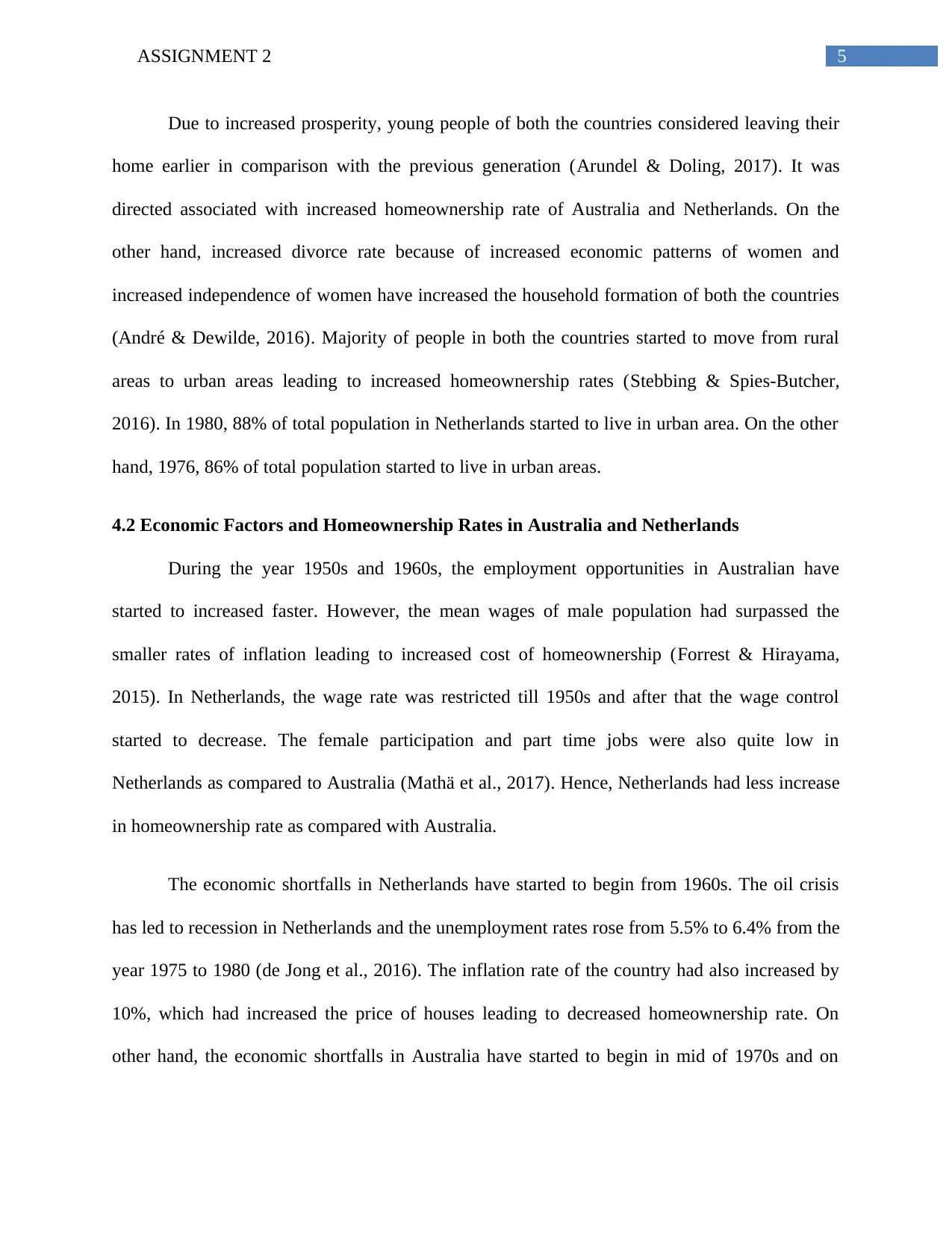
5ASSIGNMENT 2
Due to increased prosperity, young people of both the countries considered leaving their
home earlier in comparison with the previous generation (Arundel & Doling, 2017). It was
directed associated with increased homeownership rate of Australia and Netherlands. On the
other hand, increased divorce rate because of increased economic patterns of women and
increased independence of women have increased the household formation of both the countries
(André & Dewilde, 2016). Majority of people in both the countries started to move from rural
areas to urban areas leading to increased homeownership rates (Stebbing & Spies-Butcher,
2016). In 1980, 88% of total population in Netherlands started to live in urban area. On the other
hand, 1976, 86% of total population started to live in urban areas.
4.2 Economic Factors and Homeownership Rates in Australia and Netherlands
During the year 1950s and 1960s, the employment opportunities in Australian have
started to increased faster. However, the mean wages of male population had surpassed the
smaller rates of inflation leading to increased cost of homeownership (Forrest & Hirayama,
2015). In Netherlands, the wage rate was restricted till 1950s and after that the wage control
started to decrease. The female participation and part time jobs were also quite low in
Netherlands as compared to Australia (Mathä et al., 2017). Hence, Netherlands had less increase
in homeownership rate as compared with Australia.
The economic shortfalls in Netherlands have started to begin from 1960s. The oil crisis
has led to recession in Netherlands and the unemployment rates rose from 5.5% to 6.4% from the
year 1975 to 1980 (de Jong et al., 2016). The inflation rate of the country had also increased by
10%, which had increased the price of houses leading to decreased homeownership rate. On
other hand, the economic shortfalls in Australia have started to begin in mid of 1970s and on
Due to increased prosperity, young people of both the countries considered leaving their
home earlier in comparison with the previous generation (Arundel & Doling, 2017). It was
directed associated with increased homeownership rate of Australia and Netherlands. On the
other hand, increased divorce rate because of increased economic patterns of women and
increased independence of women have increased the household formation of both the countries
(André & Dewilde, 2016). Majority of people in both the countries started to move from rural
areas to urban areas leading to increased homeownership rates (Stebbing & Spies-Butcher,
2016). In 1980, 88% of total population in Netherlands started to live in urban area. On the other
hand, 1976, 86% of total population started to live in urban areas.
4.2 Economic Factors and Homeownership Rates in Australia and Netherlands
During the year 1950s and 1960s, the employment opportunities in Australian have
started to increased faster. However, the mean wages of male population had surpassed the
smaller rates of inflation leading to increased cost of homeownership (Forrest & Hirayama,
2015). In Netherlands, the wage rate was restricted till 1950s and after that the wage control
started to decrease. The female participation and part time jobs were also quite low in
Netherlands as compared to Australia (Mathä et al., 2017). Hence, Netherlands had less increase
in homeownership rate as compared with Australia.
The economic shortfalls in Netherlands have started to begin from 1960s. The oil crisis
has led to recession in Netherlands and the unemployment rates rose from 5.5% to 6.4% from the
year 1975 to 1980 (de Jong et al., 2016). The inflation rate of the country had also increased by
10%, which had increased the price of houses leading to decreased homeownership rate. On
other hand, the economic shortfalls in Australia have started to begin in mid of 1970s and on
⊘ This is a preview!⊘
Do you want full access?
Subscribe today to unlock all pages.

Trusted by 1+ million students worldwide
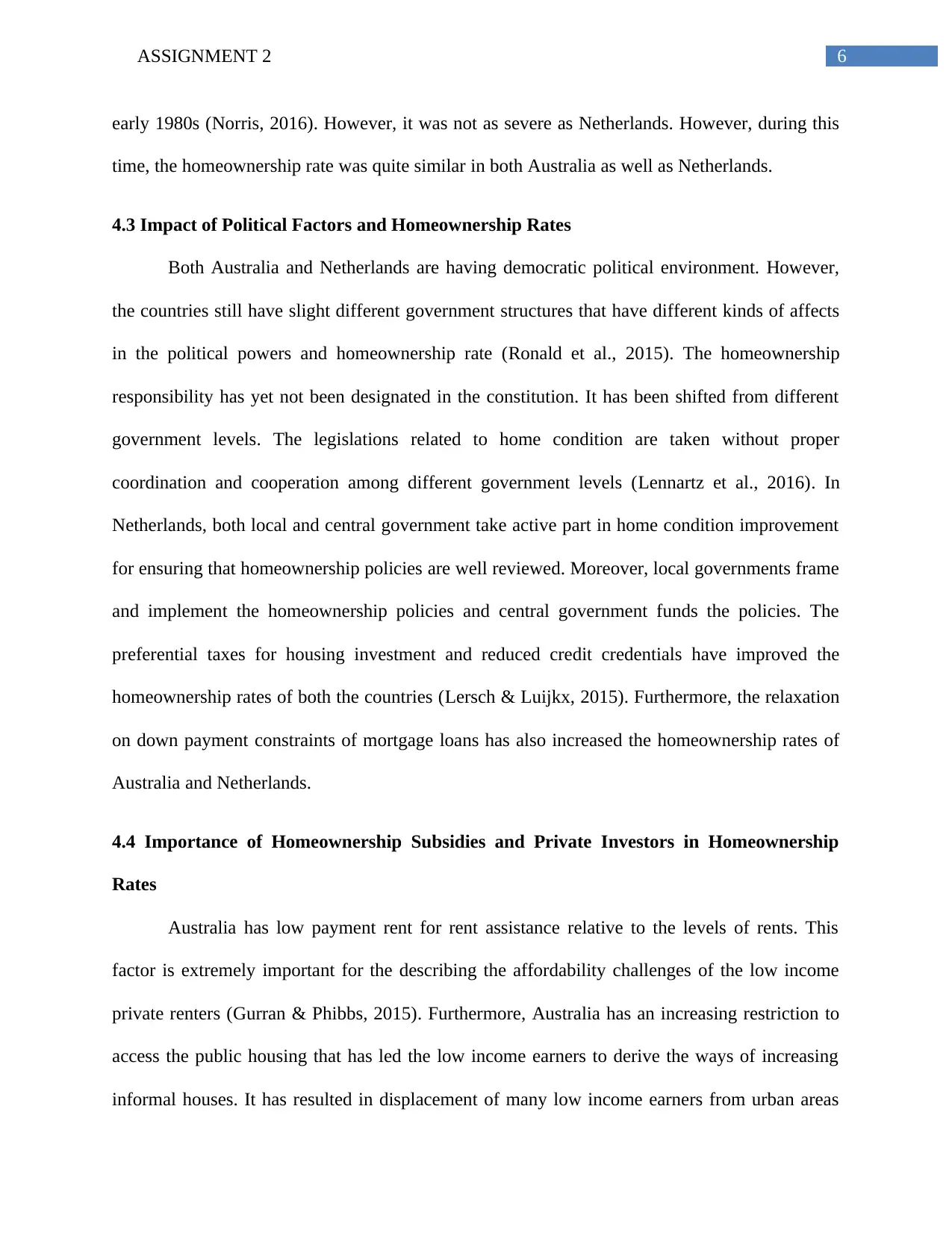
6ASSIGNMENT 2
early 1980s (Norris, 2016). However, it was not as severe as Netherlands. However, during this
time, the homeownership rate was quite similar in both Australia as well as Netherlands.
4.3 Impact of Political Factors and Homeownership Rates
Both Australia and Netherlands are having democratic political environment. However,
the countries still have slight different government structures that have different kinds of affects
in the political powers and homeownership rate (Ronald et al., 2015). The homeownership
responsibility has yet not been designated in the constitution. It has been shifted from different
government levels. The legislations related to home condition are taken without proper
coordination and cooperation among different government levels (Lennartz et al., 2016). In
Netherlands, both local and central government take active part in home condition improvement
for ensuring that homeownership policies are well reviewed. Moreover, local governments frame
and implement the homeownership policies and central government funds the policies. The
preferential taxes for housing investment and reduced credit credentials have improved the
homeownership rates of both the countries (Lersch & Luijkx, 2015). Furthermore, the relaxation
on down payment constraints of mortgage loans has also increased the homeownership rates of
Australia and Netherlands.
4.4 Importance of Homeownership Subsidies and Private Investors in Homeownership
Rates
Australia has low payment rent for rent assistance relative to the levels of rents. This
factor is extremely important for the describing the affordability challenges of the low income
private renters (Gurran & Phibbs, 2015). Furthermore, Australia has an increasing restriction to
access the public housing that has led the low income earners to derive the ways of increasing
informal houses. It has resulted in displacement of many low income earners from urban areas
early 1980s (Norris, 2016). However, it was not as severe as Netherlands. However, during this
time, the homeownership rate was quite similar in both Australia as well as Netherlands.
4.3 Impact of Political Factors and Homeownership Rates
Both Australia and Netherlands are having democratic political environment. However,
the countries still have slight different government structures that have different kinds of affects
in the political powers and homeownership rate (Ronald et al., 2015). The homeownership
responsibility has yet not been designated in the constitution. It has been shifted from different
government levels. The legislations related to home condition are taken without proper
coordination and cooperation among different government levels (Lennartz et al., 2016). In
Netherlands, both local and central government take active part in home condition improvement
for ensuring that homeownership policies are well reviewed. Moreover, local governments frame
and implement the homeownership policies and central government funds the policies. The
preferential taxes for housing investment and reduced credit credentials have improved the
homeownership rates of both the countries (Lersch & Luijkx, 2015). Furthermore, the relaxation
on down payment constraints of mortgage loans has also increased the homeownership rates of
Australia and Netherlands.
4.4 Importance of Homeownership Subsidies and Private Investors in Homeownership
Rates
Australia has low payment rent for rent assistance relative to the levels of rents. This
factor is extremely important for the describing the affordability challenges of the low income
private renters (Gurran & Phibbs, 2015). Furthermore, Australia has an increasing restriction to
access the public housing that has led the low income earners to derive the ways of increasing
informal houses. It has resulted in displacement of many low income earners from urban areas
Paraphrase This Document
Need a fresh take? Get an instant paraphrase of this document with our AI Paraphraser
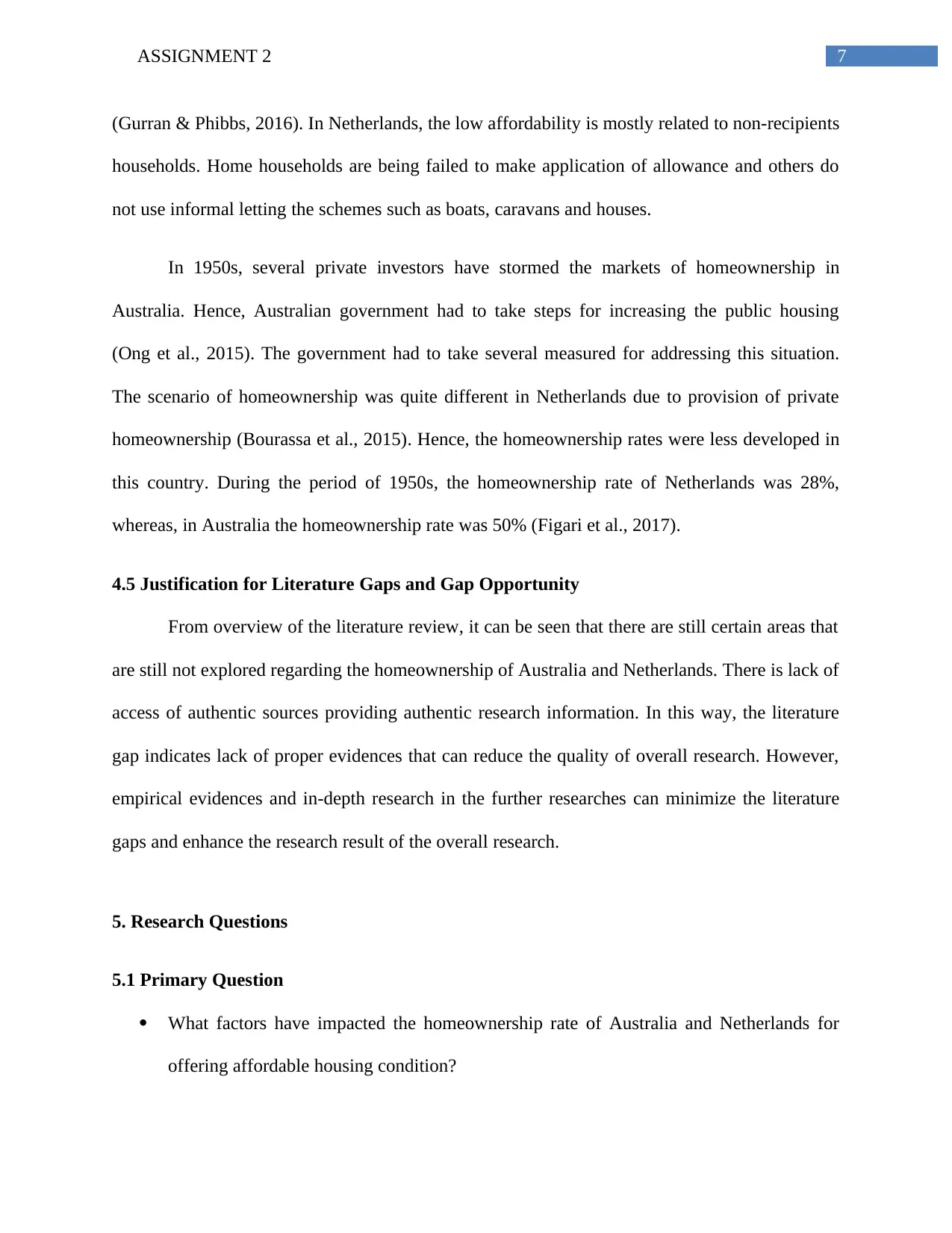
7ASSIGNMENT 2
(Gurran & Phibbs, 2016). In Netherlands, the low affordability is mostly related to non-recipients
households. Home households are being failed to make application of allowance and others do
not use informal letting the schemes such as boats, caravans and houses.
In 1950s, several private investors have stormed the markets of homeownership in
Australia. Hence, Australian government had to take steps for increasing the public housing
(Ong et al., 2015). The government had to take several measured for addressing this situation.
The scenario of homeownership was quite different in Netherlands due to provision of private
homeownership (Bourassa et al., 2015). Hence, the homeownership rates were less developed in
this country. During the period of 1950s, the homeownership rate of Netherlands was 28%,
whereas, in Australia the homeownership rate was 50% (Figari et al., 2017).
4.5 Justification for Literature Gaps and Gap Opportunity
From overview of the literature review, it can be seen that there are still certain areas that
are still not explored regarding the homeownership of Australia and Netherlands. There is lack of
access of authentic sources providing authentic research information. In this way, the literature
gap indicates lack of proper evidences that can reduce the quality of overall research. However,
empirical evidences and in-depth research in the further researches can minimize the literature
gaps and enhance the research result of the overall research.
5. Research Questions
5.1 Primary Question
What factors have impacted the homeownership rate of Australia and Netherlands for
offering affordable housing condition?
(Gurran & Phibbs, 2016). In Netherlands, the low affordability is mostly related to non-recipients
households. Home households are being failed to make application of allowance and others do
not use informal letting the schemes such as boats, caravans and houses.
In 1950s, several private investors have stormed the markets of homeownership in
Australia. Hence, Australian government had to take steps for increasing the public housing
(Ong et al., 2015). The government had to take several measured for addressing this situation.
The scenario of homeownership was quite different in Netherlands due to provision of private
homeownership (Bourassa et al., 2015). Hence, the homeownership rates were less developed in
this country. During the period of 1950s, the homeownership rate of Netherlands was 28%,
whereas, in Australia the homeownership rate was 50% (Figari et al., 2017).
4.5 Justification for Literature Gaps and Gap Opportunity
From overview of the literature review, it can be seen that there are still certain areas that
are still not explored regarding the homeownership of Australia and Netherlands. There is lack of
access of authentic sources providing authentic research information. In this way, the literature
gap indicates lack of proper evidences that can reduce the quality of overall research. However,
empirical evidences and in-depth research in the further researches can minimize the literature
gaps and enhance the research result of the overall research.
5. Research Questions
5.1 Primary Question
What factors have impacted the homeownership rate of Australia and Netherlands for
offering affordable housing condition?
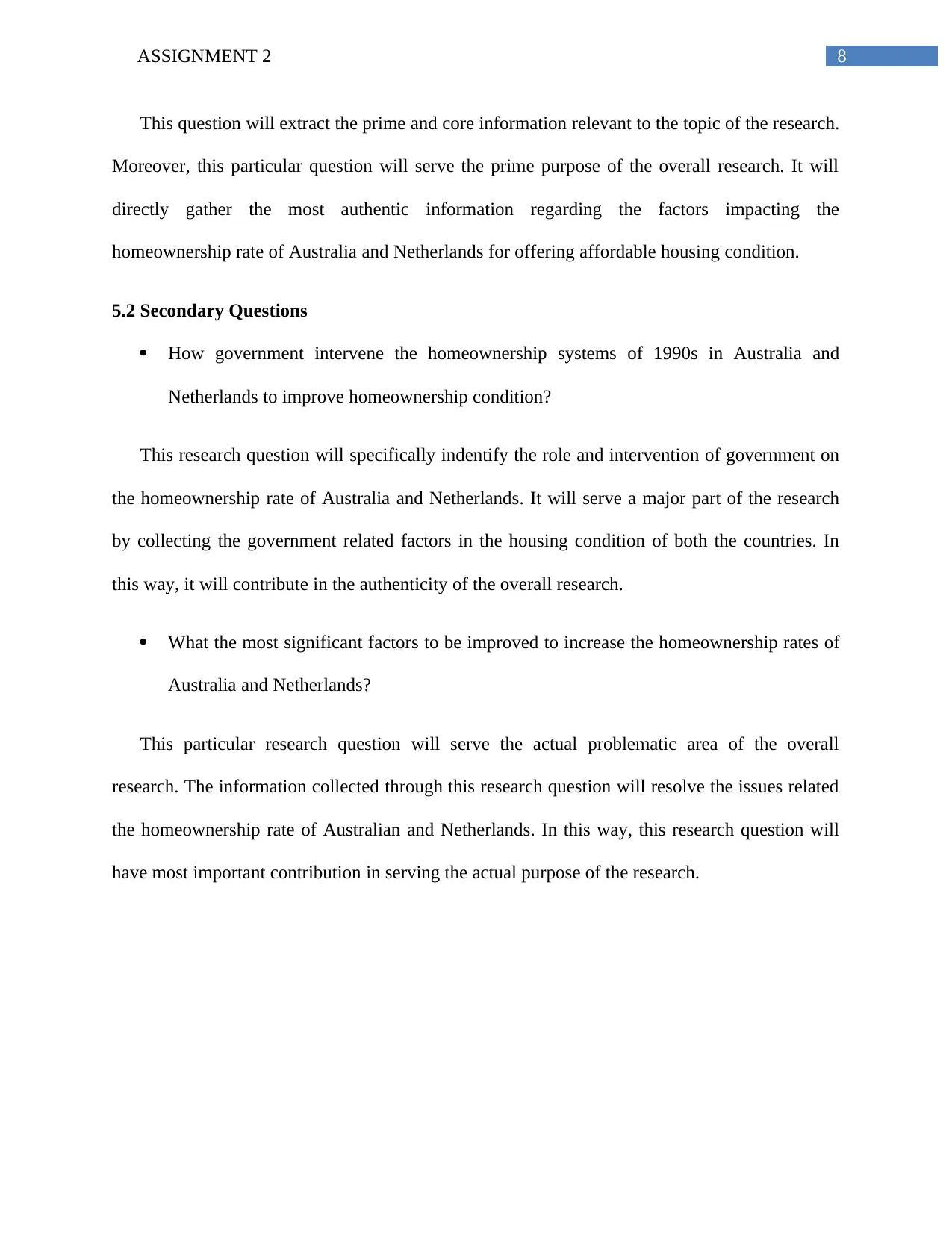
8ASSIGNMENT 2
This question will extract the prime and core information relevant to the topic of the research.
Moreover, this particular question will serve the prime purpose of the overall research. It will
directly gather the most authentic information regarding the factors impacting the
homeownership rate of Australia and Netherlands for offering affordable housing condition.
5.2 Secondary Questions
How government intervene the homeownership systems of 1990s in Australia and
Netherlands to improve homeownership condition?
This research question will specifically indentify the role and intervention of government on
the homeownership rate of Australia and Netherlands. It will serve a major part of the research
by collecting the government related factors in the housing condition of both the countries. In
this way, it will contribute in the authenticity of the overall research.
What the most significant factors to be improved to increase the homeownership rates of
Australia and Netherlands?
This particular research question will serve the actual problematic area of the overall
research. The information collected through this research question will resolve the issues related
the homeownership rate of Australian and Netherlands. In this way, this research question will
have most important contribution in serving the actual purpose of the research.
This question will extract the prime and core information relevant to the topic of the research.
Moreover, this particular question will serve the prime purpose of the overall research. It will
directly gather the most authentic information regarding the factors impacting the
homeownership rate of Australia and Netherlands for offering affordable housing condition.
5.2 Secondary Questions
How government intervene the homeownership systems of 1990s in Australia and
Netherlands to improve homeownership condition?
This research question will specifically indentify the role and intervention of government on
the homeownership rate of Australia and Netherlands. It will serve a major part of the research
by collecting the government related factors in the housing condition of both the countries. In
this way, it will contribute in the authenticity of the overall research.
What the most significant factors to be improved to increase the homeownership rates of
Australia and Netherlands?
This particular research question will serve the actual problematic area of the overall
research. The information collected through this research question will resolve the issues related
the homeownership rate of Australian and Netherlands. In this way, this research question will
have most important contribution in serving the actual purpose of the research.
⊘ This is a preview!⊘
Do you want full access?
Subscribe today to unlock all pages.

Trusted by 1+ million students worldwide
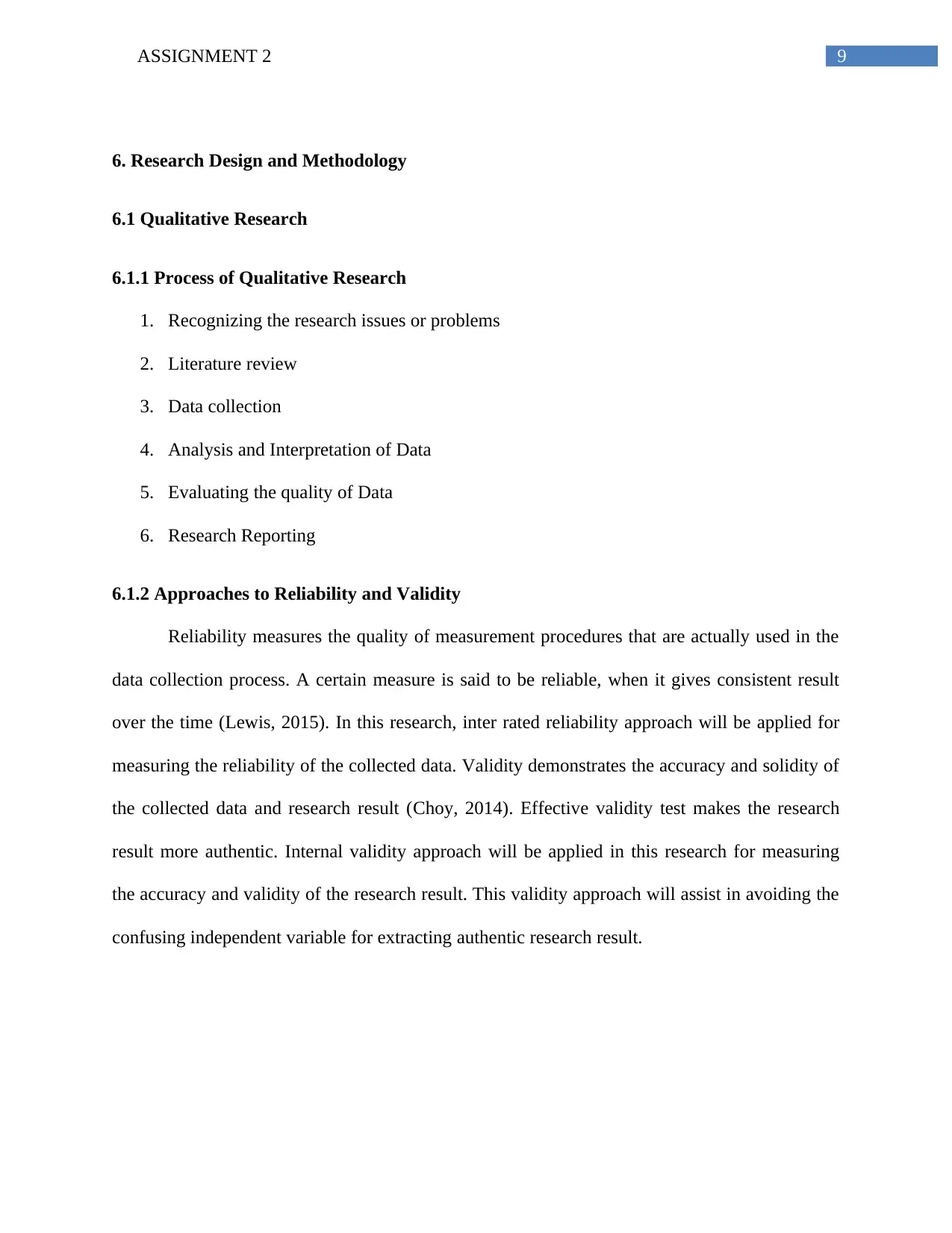
9ASSIGNMENT 2
6. Research Design and Methodology
6.1 Qualitative Research
6.1.1 Process of Qualitative Research
1. Recognizing the research issues or problems
2. Literature review
3. Data collection
4. Analysis and Interpretation of Data
5. Evaluating the quality of Data
6. Research Reporting
6.1.2 Approaches to Reliability and Validity
Reliability measures the quality of measurement procedures that are actually used in the
data collection process. A certain measure is said to be reliable, when it gives consistent result
over the time (Lewis, 2015). In this research, inter rated reliability approach will be applied for
measuring the reliability of the collected data. Validity demonstrates the accuracy and solidity of
the collected data and research result (Choy, 2014). Effective validity test makes the research
result more authentic. Internal validity approach will be applied in this research for measuring
the accuracy and validity of the research result. This validity approach will assist in avoiding the
confusing independent variable for extracting authentic research result.
6. Research Design and Methodology
6.1 Qualitative Research
6.1.1 Process of Qualitative Research
1. Recognizing the research issues or problems
2. Literature review
3. Data collection
4. Analysis and Interpretation of Data
5. Evaluating the quality of Data
6. Research Reporting
6.1.2 Approaches to Reliability and Validity
Reliability measures the quality of measurement procedures that are actually used in the
data collection process. A certain measure is said to be reliable, when it gives consistent result
over the time (Lewis, 2015). In this research, inter rated reliability approach will be applied for
measuring the reliability of the collected data. Validity demonstrates the accuracy and solidity of
the collected data and research result (Choy, 2014). Effective validity test makes the research
result more authentic. Internal validity approach will be applied in this research for measuring
the accuracy and validity of the research result. This validity approach will assist in avoiding the
confusing independent variable for extracting authentic research result.
Paraphrase This Document
Need a fresh take? Get an instant paraphrase of this document with our AI Paraphraser
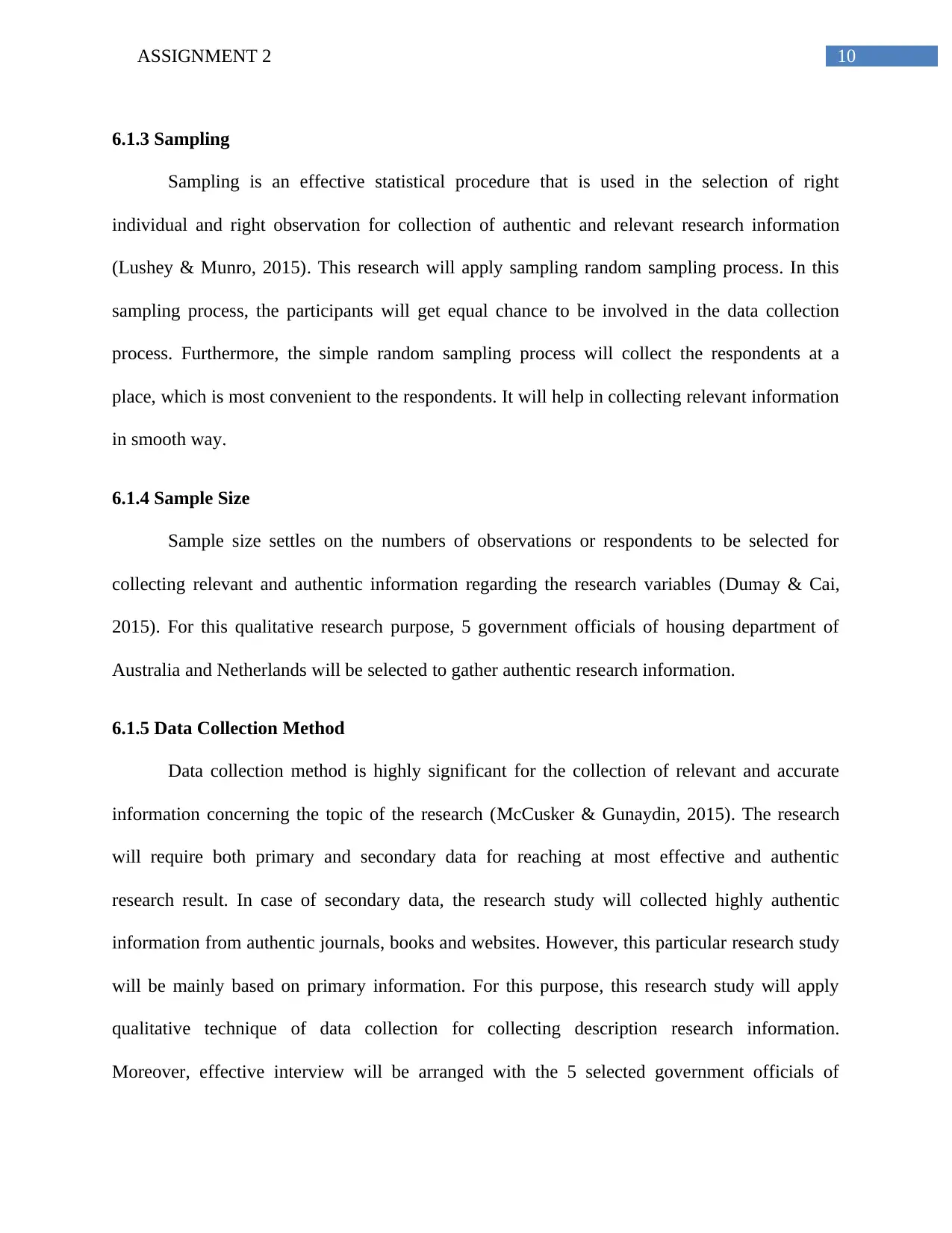
10ASSIGNMENT 2
6.1.3 Sampling
Sampling is an effective statistical procedure that is used in the selection of right
individual and right observation for collection of authentic and relevant research information
(Lushey & Munro, 2015). This research will apply sampling random sampling process. In this
sampling process, the participants will get equal chance to be involved in the data collection
process. Furthermore, the simple random sampling process will collect the respondents at a
place, which is most convenient to the respondents. It will help in collecting relevant information
in smooth way.
6.1.4 Sample Size
Sample size settles on the numbers of observations or respondents to be selected for
collecting relevant and authentic information regarding the research variables (Dumay & Cai,
2015). For this qualitative research purpose, 5 government officials of housing department of
Australia and Netherlands will be selected to gather authentic research information.
6.1.5 Data Collection Method
Data collection method is highly significant for the collection of relevant and accurate
information concerning the topic of the research (McCusker & Gunaydin, 2015). The research
will require both primary and secondary data for reaching at most effective and authentic
research result. In case of secondary data, the research study will collected highly authentic
information from authentic journals, books and websites. However, this particular research study
will be mainly based on primary information. For this purpose, this research study will apply
qualitative technique of data collection for collecting description research information.
Moreover, effective interview will be arranged with the 5 selected government officials of
6.1.3 Sampling
Sampling is an effective statistical procedure that is used in the selection of right
individual and right observation for collection of authentic and relevant research information
(Lushey & Munro, 2015). This research will apply sampling random sampling process. In this
sampling process, the participants will get equal chance to be involved in the data collection
process. Furthermore, the simple random sampling process will collect the respondents at a
place, which is most convenient to the respondents. It will help in collecting relevant information
in smooth way.
6.1.4 Sample Size
Sample size settles on the numbers of observations or respondents to be selected for
collecting relevant and authentic information regarding the research variables (Dumay & Cai,
2015). For this qualitative research purpose, 5 government officials of housing department of
Australia and Netherlands will be selected to gather authentic research information.
6.1.5 Data Collection Method
Data collection method is highly significant for the collection of relevant and accurate
information concerning the topic of the research (McCusker & Gunaydin, 2015). The research
will require both primary and secondary data for reaching at most effective and authentic
research result. In case of secondary data, the research study will collected highly authentic
information from authentic journals, books and websites. However, this particular research study
will be mainly based on primary information. For this purpose, this research study will apply
qualitative technique of data collection for collecting description research information.
Moreover, effective interview will be arranged with the 5 selected government officials of
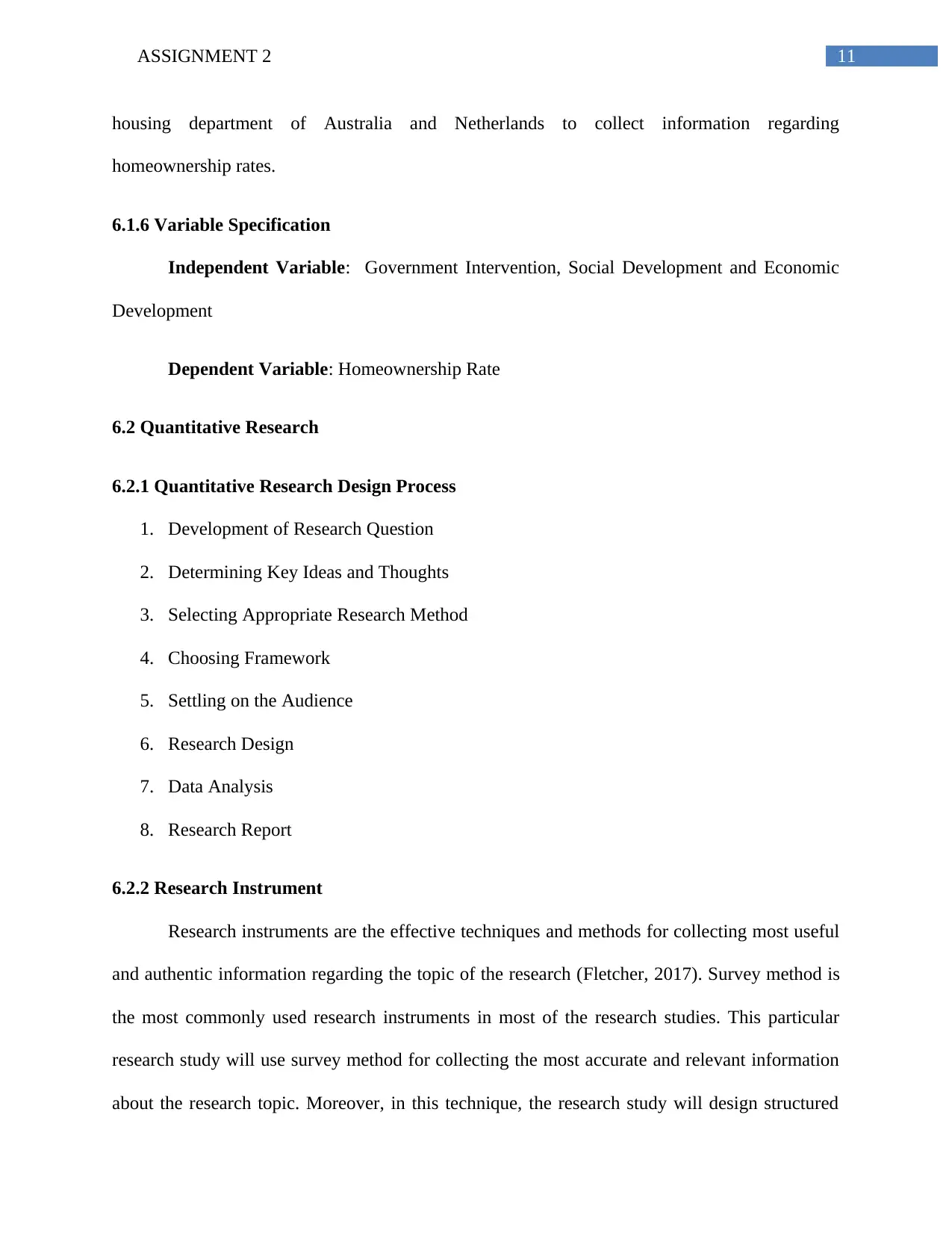
11ASSIGNMENT 2
housing department of Australia and Netherlands to collect information regarding
homeownership rates.
6.1.6 Variable Specification
Independent Variable: Government Intervention, Social Development and Economic
Development
Dependent Variable: Homeownership Rate
6.2 Quantitative Research
6.2.1 Quantitative Research Design Process
1. Development of Research Question
2. Determining Key Ideas and Thoughts
3. Selecting Appropriate Research Method
4. Choosing Framework
5. Settling on the Audience
6. Research Design
7. Data Analysis
8. Research Report
6.2.2 Research Instrument
Research instruments are the effective techniques and methods for collecting most useful
and authentic information regarding the topic of the research (Fletcher, 2017). Survey method is
the most commonly used research instruments in most of the research studies. This particular
research study will use survey method for collecting the most accurate and relevant information
about the research topic. Moreover, in this technique, the research study will design structured
housing department of Australia and Netherlands to collect information regarding
homeownership rates.
6.1.6 Variable Specification
Independent Variable: Government Intervention, Social Development and Economic
Development
Dependent Variable: Homeownership Rate
6.2 Quantitative Research
6.2.1 Quantitative Research Design Process
1. Development of Research Question
2. Determining Key Ideas and Thoughts
3. Selecting Appropriate Research Method
4. Choosing Framework
5. Settling on the Audience
6. Research Design
7. Data Analysis
8. Research Report
6.2.2 Research Instrument
Research instruments are the effective techniques and methods for collecting most useful
and authentic information regarding the topic of the research (Fletcher, 2017). Survey method is
the most commonly used research instruments in most of the research studies. This particular
research study will use survey method for collecting the most accurate and relevant information
about the research topic. Moreover, in this technique, the research study will design structured
⊘ This is a preview!⊘
Do you want full access?
Subscribe today to unlock all pages.

Trusted by 1+ million students worldwide
1 out of 19
Related Documents
Your All-in-One AI-Powered Toolkit for Academic Success.
+13062052269
info@desklib.com
Available 24*7 on WhatsApp / Email
![[object Object]](/_next/static/media/star-bottom.7253800d.svg)
Unlock your academic potential
Copyright © 2020–2025 A2Z Services. All Rights Reserved. Developed and managed by ZUCOL.





